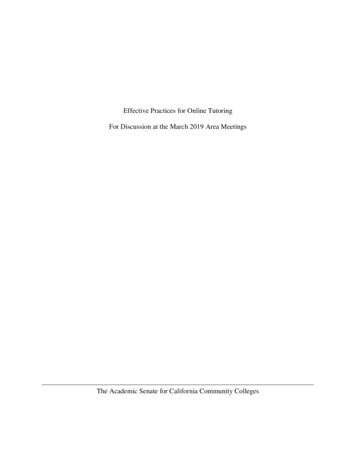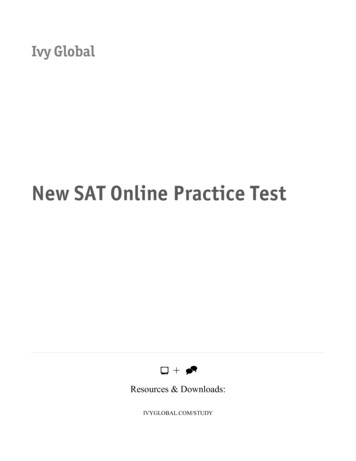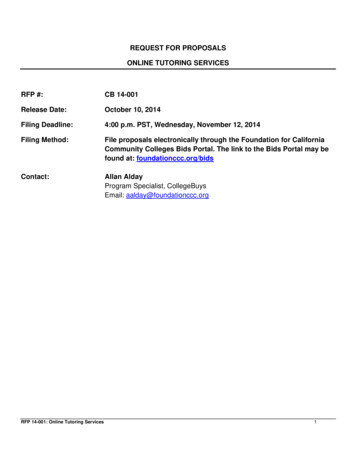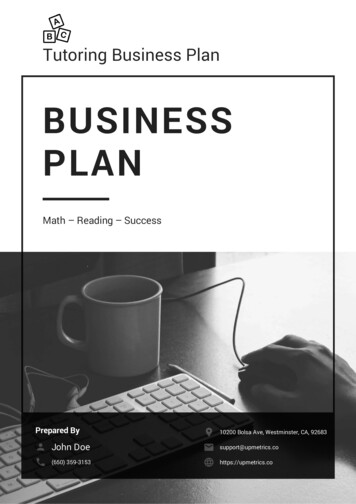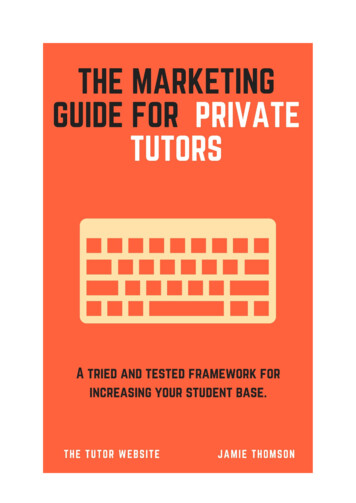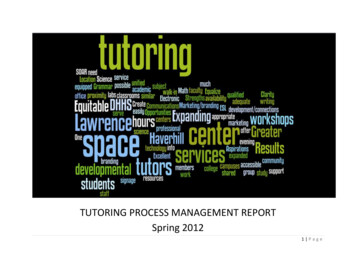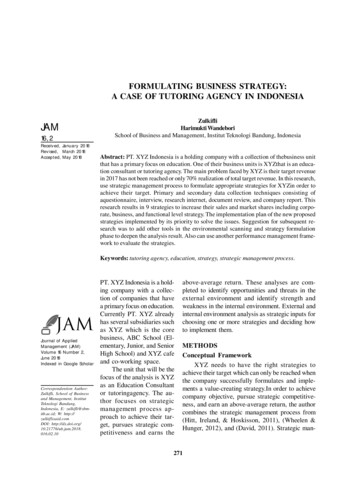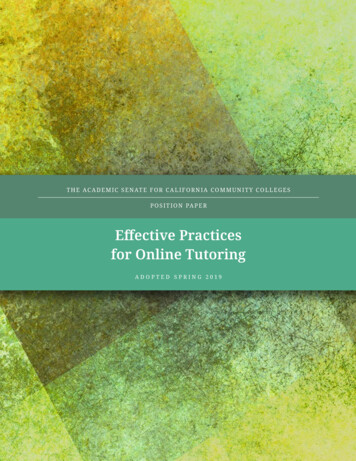
Transcription
T H E A C A D E M I C S E N AT E F O R C A L I F O R N I A C O M M U N I T Y C O L L E G E SP O S I T I O N PA P E REffective Practicesfor Online TutoringADOPTED SPRING 2019
T H E T R A N S F E R , A R T I C U L AT I O N , A N DSTUDENT SERVICES COMMITTEE 2018-2019Michelle Velasquez Bean, Chair, Rio Hondo CollegeTeresa Aldredge, Cosumnes River CollegeKaren Chow, De Anza CollegeLynn Fowler, American River CollegeArthur Guaracha, Southwestern CollegeTanya McGinnis, Antelope Valley CollegeLaTonya Parker, Moreno Valley CollegeGraciela Saez-Kleriga, Southwestern College
TABLE OF CONTENTSIntroduction . . . . . . . . . . . . . . . . . . . . . . . . . . . . . . . . . . . . . . . . . . . . . . . . . . . . 1How To Use This Paper . . . . . . . . . . . . . . . . . . . . . . . . . . . . . . . . . . . . . . . . . . . . . 1Justification for the Paper . . . . . . . . . . . . . . . . . . . . . . . . . . . . . . . . . . . . . . . . . . . . 1Accreditation and Online Tutoring . . . . . . . . . . . . . . . . . . . . . . . . . . . . . . . . . . . . . . 2The Value and Benefits of Online Tutoring . . . . . . . . . . . . . . . . . . . . . . . . . . . . . . . . . . 4Audiences for Online Tutoring . . . . . . . . . . . . . . . . . . . . . . . . . . . . . . . . . . . . . . . . . 4Online Tutoring Skills and Practices . . . . . . . . . . . . . . . . . . . . . . . . . . . . . . . . . . . . . 5Online Tutoring Interfaces and Resources . . . . . . . . . . . . . . . . . . . . . . . . . . . . . . . 5NetTutor Service . . . . . . . . . . . . . . . . . . . . . . . . . . . . . . . . . . . . . . . . . . 6Local Service . . . . . . . . . . . . . . . . . . . . . . . . . . . . . . . . . . . . . . . . . . . . 6Online Tutoring Center versus Online Resources . . . . . . . . . . . . . . . . . . . . . . . . . . 7Video Conferencing and Campus Services . . . . . . . . . . . . . . . . . . . . . . . . . . . . . . . 7The Role of the Coordinator . . . . . . . . . . . . . . . . . . . . . . . . . . . . . . . . . . . . . . . 8Preparing the Tutee . . . . . . . . . . . . . . . . . . . . . . . . . . . . . . . . . . . . . . . . . . . . 9Training and Ongoing Professional Development for In-House Tutors . . . . . . . . . . . . . 10Scaffolding, Digital Badges, and Videos . . . . . . . . . . . . . . . . . . . . . . . . . . . . . . . 11Scaffolding . . . . . . . . . . . . . . . . . . . . . . . . . . . . . . . . . . . . . . . . . . . . . . . . 11Digital Badges . . . . . . . . . . . . . . . . . . . . . . . . . . . . . . . . . . . . . . . . . . . . . . . 12Video . . . . . . . . . . . . . . . . . . . . . . . . . . . . . . . . . . . . . . . . . . . . . . . . . . . 12Challenges and Parameters of Use of Services . . . . . . . . . . . . . . . . . . . . . . . . . . . . . . . 13Challenges to Effective Online Tutoring . . . . . . . . . . . . . . . . . . . . . . . . . . . . . . . 13Institutional Challenges . . . . . . . . . . . . . . . . . . . . . . . . . . . . . . . . . . . . . 14Tutor Challenges . . . . . . . . . . . . . . . . . . . . . . . . . . . . . . . . . . . . . . . . . 14Tutee Challenges . . . . . . . . . . . . . . . . . . . . . . . . . . . . . . . . . . . . . . . . . 15Parameters of Use of Services . . . . . . . . . . . . . . . . . . . . . . . . . . . . . . . . . . . . . 15Confidentiality . . . . . . . . . . . . . . . . . . . . . . . . . . . . . . . . . . . . . . . . . . 15Plagiarism . . . . . . . . . . . . . . . . . . . . . . . . . . . . . . . . . . . . . . . . . . . . . 16Log-In Systems and Use of Services . . . . . . . . . . . . . . . . . . . . . . . . . . . . . . 16Drop-Ins, No Shows, and Cancellations . . . . . . . . . . . . . . . . . . . . . . . . . . . . 16Americans with Disabilities Act (ADA) Compliance . . . . . . . . . . . . . . . . . . . . . . . . . . . . 16Conclusion . . . . . . . . . . . . . . . . . . . . . . . . . . . . . . . . . . . . . . . . . . . . . . . . . . . 17Recommendations For Practice . . . . . . . . . . . . . . . . . . . . . . . . . . . . . . . . . . . . . . . 19References . . . . . . . . . . . . . . . . . . . . . . . . . . . . . . . . . . . . . . . . . . . . . . . . . . . 21Appendices . . . . . . . . . . . . . . . . . . . . . . . . . . . . . . . . . . . . . . . . . . . . . . . . . . . 22
1 EFFECTIVE PRACTICES FOR ONLINE TUTORINGINTRODUCTIONAs institutions of higher education seek to support students through innovative learning and teachingmethods, many colleges have begun to investigate the opportunity to provide tutoring throughdistance education formats. Support for student success is not limited to face-to-face interactionswithin the classroom. As awareness of online tutoring and its role in supporting community collegestudents increases, many colleges have set goals to eliminate barriers in providing student successsupport by implementing effective practices for online tutoring programs.Shifting demographics within the state of California and more specifically within the CaliforniaCommunity College System have created a need for equitable processes to promote the successof students. Students who enter community colleges should be afforded the same level of supportwhether they enter virtually or in-person. The development of the Online Education Initiativehas sparked great interest and collaboration within the system to support students’ successfulcompletion of courses by using services such as online tutoring. Framing the need to innovateand reimagine the way institutions serve students in a continually adapting and evolving world oftechnology is equally valuable and important. Colleges must meet the needs of all students whomay have barriers to success, such as full workloads along with course commitments and otherbarriers that impact diverse student populations.HOW TO USE THIS PAPERThis document was created by the Transfer, Articulation, and Student Services Committee (TASSC) ofthe Academic Senate for California Community Colleges and is intended for local academic senates touse as a guide for online tutoring considerations. It may also be used to assist community colleges withthe development of effective practices for online tutoring programs. Information provided in this papermay help to develop, enhance, identify, and address areas of both value and concern for online tutoringprograms. As such, this paper contains multiple sections that include the following: 1) Accreditationand Online Tutoring, 2) The Value and Benefits of Online Tutoring, 3) Audiences for Online Tutoring, 4)Online Tutoring Skills and Practices, 5) Challenges and Parameters of Services, and 6) Recommendationsfor Practice.JUSTIFICATION FOR THE PAPERDuring the Spring 2008 Plenary Session of the Academic Senate for California Community Colleges(ASCCC), the voting delegates passed Resolution 13.04 SP08 Effective Practices for Online Tutoring, whichread as follows:Whereas, Distance education has become a significant portion of California community collegeofferings, and parallel and equivalent services need to be offered to all students;Whereas, Online academic tutoring services for distance education students are being implementedacross the state as online programs expand; and
2 EFFECTIVE PRACTICES FOR ONLINE TUTORINGWhereas, Tutoring services are an effective means of supporting students, and faculty areconcerned with student success and academic quality;Resolved, That the Academic Senate for California Community Colleges research and prepare a paperthat addresses effective and non-effective practices for establishing online tutoring programs.In fall of 2012, after a period of research and information collection, the ASCCC’s Counseling and LibraryFaculty Issues Committee published the Rostrum article “Successful Online Tutoring Part I: GettingStarted,” which briefly discussed interest, need, and initial implementation strategies for colleges seekingto build online tutoring programs (Smith, 2012). When the Online Education Initiative began in 2014, anOEI workgroup that included ASCCC representatives began investigating online tutoring platforms andpiloting effective practices in conducting online tutoring.In fall of 2018, the charge of writing a paper fully addressing the challenges, benefits, and effectivepractices of online tutoring was assigned to the members of the TASSC. In response to the changingneeds of distance education and the challenges of meeting the needs of diverse student populations, theTASSC also consulted with leaders in the field. The Association of Colleges for Tutoring and LearningAssistance (ACTLA) is developing a set of recommended criteria for online tutoring at the time of thispaper’s publication.1 Once published, ACTLA’s recommendations may be used to support this paperin assisting colleges and local academic senates seeking to build programs, procedures, and effectivepractices for online tutoring.ACCREDITATION AND ONLINE TUTORINGInstitutional effectiveness under accreditation standards is driven by a campus-wide effort to meet theneeds of students, and the growing interest in developing online tutoring programs could be an additionaland viable campus resource for student success programs seeking to meet those standards. Accordingto the Accrediting Commission for Community and Junior Colleges (ACCJC), accredited institutions aremost successful when curriculum, programs, and services foster student learning and achievement viadata-informed program design, implementation, and assessment. Two types of accreditation apply tocommunity colleges: institutional—evaluation of overall campus—and programmatic—evaluation ofprograms, courses of study, etc. Both are important, as programmatic goals support institutional goals;thus, the development of an effective online tutoring program could support a college’s institutional goals.The ACCJC standards published in 2014 include four areas as a framework to promote student success: Standard I: Mission, Academic Quality and Institutional Effectiveness, and Integrity Standard II: Student Learning Programs and Support Services Standard III: Resources Standard IV: Leadership and Governance1 For more information and documents, see ACTLA’s website at http://actla.info/.
3 EFFECTIVE PRACTICES FOR ONLINE TUTORINGAn online tutoring program could help to satisfy these standards in a number of ways, as demonstratedthrough the following examples:An effective online tutoring program’s goals and outcomes should be aligned with the overall mission ofthe institution to ensure high-quality programming, evidence of student learning, and intentional useof resources (Standard I.A.1, Standard I.B.7). They should be designed using short-term and long-termgoals, learning outcomes, and a continuous assessment of services to uphold institutional effectiveness.These practices will lead to a highly successful, comprehensive program review focused on studentdevelopment and achievement. For example, colleges that can collect student demographic data—suchas gender, age, major, course, enrollment status, units completed, degree goal, and grade point average—and affective outcomes detailing students’ feelings and attitudes of services—such as availability oftutors, program hours, validation, and technology—have a greater likelihood of creating programs thatmeet their students’ individual needs.To support instructional programs and student learning, online tutoring services should meet theneeds of students via equitable access to tutoring and a continuous assessment of student progress,learning, and success, regardless of service location and delivery method (Standard II.A.7, StandardII.B.1). Moreover, in designing effective online tutoring programs, colleges should view students froman asset-based learning lens that recognizes the skills and strengths of students. This framework seeksto empower students by helping them understand and apply the knowledge and experience they bringto the learning session. This concept can help increase students’ confidence and critical thinking, whichpromotes students viewing themselves as leaders and teachers in a transaction of learning rather thanmerely learning content through a transmission of information (Metz and Bezuidenhout, 2017; Peacockand Cowan, 2016).Human, physical, technology, and financial support are needed to ensure program success. Colleges mustinvest in training and technology that provides the greatest opportunity for successful development andimplementation of services (Standard III.C.4, Standard III.D.16). When a college considers developinglearning support services, it must ensure those resources are accessible and well-maintained andthat they are regularly evaluated for their effectiveness (Standard I.B.4). This process should includedeveloping resources for the program and students alike. For example, colleges can purchase softwareor use online platforms that support the short-term and long-term goals of the online tutoring program.Additionally, colleges can proactively remove barriers that may prevent students from accessing theservices. This equity-driven practice includes ensuring students have reliable wireless internet oncampus and accessible computer labs with any necessary equipment for online tutoring sessions oropportunities to rent or purchase discounted tablets or electronic devices.The hiring, development, and support of qualified personnel is also needed to create an effective onlineprogram. Tutors must be well-versed in the use of technology, subject matter, and tutoring strategies, suchas building a welcoming and engaging online environment for students (Metz and Bezuidenhout, 2017).Periodic evaluations and training for personnel are important to ensuring the quality and standards ofservice. These standards and professional development opportunities must be aligned with the overallgoals of the program and of the institution.
4 EFFECTIVE PRACTICES FOR ONLINE TUTORINGSupportive leadership is key for programmatic success (Standard IV.A.1). Campus leaders, includingboards of trustees, presidents or superintendents, vice presidents, deans, and faculty, should be wellinformed of the tutoring program’s goals, challenges, and achievements, as these individuals have accessto financial, technological, physical or facilities, and social or networking resources that can aid in theadvancement and continuation of tutoring services for students.The Value and Benefits of Online TutoringOnline tutoring can provide benefits for all students as well as for the institution and the faculty. Effectiveonline tutoring creates supplemental opportunities for students enrolled in all types of courses: face-toface, hybrid, and online. These programs are an essential resource for community college students wholargely commute to campus and have external factors that compete for their time.Online environments for completion of courses, degrees, counseling, and tutoring are becoming moreprevalent in higher education. The number of students taking online courses has increased dramaticallyin recent years. A U.S. News article reports that federal data from a study conducted by Babson SurveyResearch Group of more than 4,700 colleges and universities found that more than 6.3 million studentsin the United States took at least one online course in fall 2016, a 5.6 percent increase from the previousyear (Friedman, 2018). The article also states that 2016 was the fourteenth consecutive year of reportedgrowth in online enrollment. Similarly, distance education has nearly tripled in the California communitycolleges over the last twelve years. For example, a total of 860,283 unduplicated students enrolled in adistance education course during the 2016-2017 academic year compared to 328,372 during the 20052006 year (California Community College Chancellor’s Office, 2017). To support these students, collegeshave increased their online services to include advising, counselling, and tutoring. A recent CommunityCollege Success Network (2015) tutor center survey found that 47 colleges offered tutoring through alearning center (83% of respondents), followed by online platforms (56%) or computer labs (56%), incomparison to the use of traditional classrooms (40%), multipurpose space (28%), or the library (15%).Because of this growing trend, learning centers have found a need to incorporate technology and otheronline resources to adapt and meet the needs of students. Online tutoring allows students who haveobstacles or barriers to receiving in-person campus assistance the equitable opportunity for successservices beyond the boundaries of the physical campus space.Online tutoring proactively creates opportunities to engage students in their communities by using amyriad of access modalities, such as via phone, e-mail, or computer or video conferencing platforms.Similar to face-to-face learning assistance programs, online tutoring can help students enrolled inmultiple courses from various disciplines. Online tutoring programs may assist students with manyneeds for course success, such as the development of ideas, organization of information, formatting ofresearch papers, and preparation for exams, to name just a few activities. To achieve success in theseareas, online experiences for tutors and students must be equivalent to face-to-face tutoring services.Audiences for Online TutoringThe California Community College System serves 2.4 million students at 114 community colleges. Manyof these students commute to campus, work off-campus in part-time or full-time situations, and may
5 EFFECTIVE PRACTICES FOR ONLINE TUTORINGhave family or individual responsibilities that can create barriers to success. These factors competefor students’ time and can impact their enrollment decisions, their use of campus services, and otheraspects of their academic experience. To positively support students, many colleges have created variousmethods of course delivery, including traditional face-to-face classrooms where students attend lecturesin-person, hybrid or blended classrooms where a specified number of course hours include onlinelearning in addition to face-to-face attendance, and online courses where students do not meet in aphysical classroom so that learning can be accessed anytime within any space. Online tutoring can be aflexible resource designed to support students within all of these course delivery methods.As noted in the Rostrum article “Successful Online Tutoring,” “The goal of online tutoring is to createa virtual tutoring environment for students that emulates a face-to-face experience which can help astudent achieve success in a given class” (Smith, 2012). As such, online tutoring was designed to meet theneeds of all community college students, and these servic
Karen Chow, De Anza College Lynn Fowler, American River College Arthur Guaracha, Southwestern College Tanya McGinnis, Antelope Valley College . methods, many colleges have begun to investigate the opportunity to provide tutoring through distance education formats. Support for st
